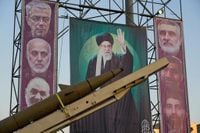Iran’s Supreme Leader, Ayatollah Ali Khamenei, stepped into public view on Saturday, September 27, 2025, for the first time since the fierce 12-day war between Israel and Iran erupted in June. His appearance at a mourning ceremony on the eve of Ashoura, held at a mosque adjacent to his office and residence in Tehran, came after weeks of speculation about his whereabouts during the conflict. As reported by state television and confirmed by multiple sources, Khamenei entered to a standing, chanting crowd, waving and nodding in acknowledgment, a scene heavy with symbolism and security.
Khamenei’s absence during the war had fueled rumors of his seclusion in a secure bunker, a notion neither confirmed nor denied by Iranian state media. The stakes of his reemergence were underscored by the presence of top Iranian officials, including the parliament speaker, and the heightened security surrounding the event. According to AP and BBC reports, there was no immediate public statement from Khamenei during the ceremony, leaving observers to parse the significance of his attendance alone.
The ceremony itself marked the martyrdom of Hussein, the Prophet Muhammad’s grandson—a pivotal event in Shiite Islam that continues to shape religious and political identity in Iran. Red flags, representing Hussein’s blood, and black funeral tents and clothing set the somber tone, while processions of chest-beating and self-flagellating men expressed the community’s fervor. In the sweltering heat, mourners were sprayed with water, a small relief amid the intensity of the rituals. As Al Jazeera notes, Shiites make up over 10% of the world’s 1.8 billion Muslims, and the commemoration of Hussein’s death at Karbala remains a defining moment for the faith.
Yet, the backdrop to this year’s Ashoura was anything but ordinary. The war with Israel, which lasted 12 days as of late September, left a heavy toll on both nations. Iran has acknowledged more than 900 deaths and thousands more injured within its borders. The country also confirmed serious damage to its nuclear facilities, a direct result of U.S. airstrikes on three key sites during the conflict. The strikes, as reported by The Times of Israel, were part of a broader campaign by Israel targeting Iran’s defense systems, high-ranking military officials, and atomic scientists. The Israeli government justified its actions by claiming it sought to prevent Iran from developing atomic weapons—a charge Iran has consistently denied, even as it enriched uranium to levels with no peaceful application and blocked international inspectors from its facilities.
As the dust settled, the diplomatic fallout was swift. On Wednesday, September 24, Iran’s president ordered a suspension of cooperation with the International Atomic Energy Agency (IAEA), further limiting inspectors’ ability to monitor the country’s nuclear activities. According to Reuters, this move has heightened Western fears that Iran’s uranium enrichment could lead to an atomic warhead and that its expanding ballistic missile program might one day deliver such a weapon. The United States and several European nations have continued to press for restrictions on Iran’s missile capabilities, but these demands remain a major stumbling block in efforts to revive a nuclear deal.
In response to the attacks on its soil, Iran unleashed a barrage of more than 550 ballistic missiles at Israel, the majority of which were intercepted by Israeli defense systems. Nevertheless, the strikes resulted in 28 deaths and widespread damage across the country. As detailed by The Times of Israel, over 500 ballistic missiles and approximately 1,100 drones were launched, causing 36 missile impacts and one drone strike in populated areas. The attacks damaged 2,305 homes in 240 buildings, two universities, and a hospital, leaving over 13,000 Israelis displaced and more than 3,000 wounded.
Military tensions were on full display at a military exhibition held on Thursday, September 25, at Baharestan Square in Tehran. The event commemorated both the anniversary of the 1980-88 Iraq-Iran war and the recent conflict with Israel. Among the displays was the domestically-built “Khaibar-buster” missile, flanked by banners of Khamenei and late armed forces commanders killed in Israeli strikes. The exhibition served as a stark reminder of Iran’s ongoing commitment to strengthening its military capabilities, particularly its missile arsenal.
Amid growing Western pressure, a senior commander of Iran’s Islamic Revolutionary Guard Corps (IRGC), Mohammadjafar Asadi, made headlines by declaring, “Our missiles will reach the range that they need to.” Speaking to the semi-official Fars news agency on Wednesday, October 1, Asadi emphasized that the power and range of Iranian missiles had limited the June war to just 12 days, and hinted that extending missile range would enhance Iran’s deterrence in any future conflict with Israel. Previously, Iranian missiles had a self-imposed range limit of 2,000 kilometers (1,200 miles), deemed sufficient to reach Israel. However, after Israeli strikes targeted launchers in western Iran, Tehran began launching missiles from further east, necessitating greater range and capability.
Western officials, particularly from the U.S. and Europe, have voiced deep concerns that Iran’s missile and nuclear ambitions threaten regional and global security. According to Reuters, these concerns have blocked progress toward a new nuclear agreement, with the U.S. in particular demanding greater transparency and limits on Iran’s missile program. The Iranian government, for its part, insists it has no intention of acquiring nuclear weapons, though its actions—such as enriching uranium to near weapons-grade levels and denying access to international inspectors—have only fueled suspicion.
The war’s impact extended beyond the battlefield. In the midst of Khamenei’s ceremony, NetBlocks, a global internet monitor, reported a “major disruption to internet connectivity” across Iran late Saturday, September 27. The outage, which lasted about two hours, corroborated widespread reports from users unable to access the internet. This followed earlier telecom shutdowns during the war, a tactic authorities have used to control information flow during periods of unrest or conflict. NetBlocks confirmed that internet access was restored after the brief blackout, but the incident highlighted the government’s willingness to restrict digital communications during times of crisis.
Meanwhile, the international community watches with apprehension. The war’s aftermath leaves Iran’s nuclear facilities damaged, its cooperation with the IAEA suspended, and its missile program advancing in defiance of Western demands. Israel, still reeling from the missile and drone attacks, faces the challenge of rebuilding and protecting its citizens amid persistent threats. For ordinary Iranians and Israelis, the scars of war are fresh, the political climate tense, and the road to peace as uncertain as ever.
As Ayatollah Khamenei reemerges and Iran signals its intent to expand its missile reach, the world is left to wonder: what comes next in this volatile standoff?




